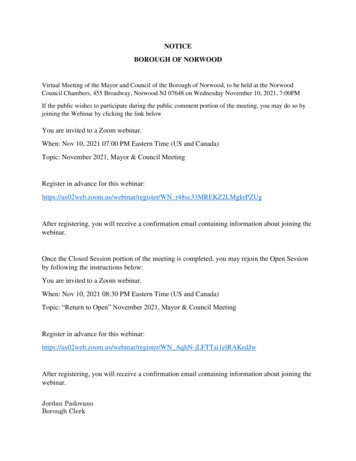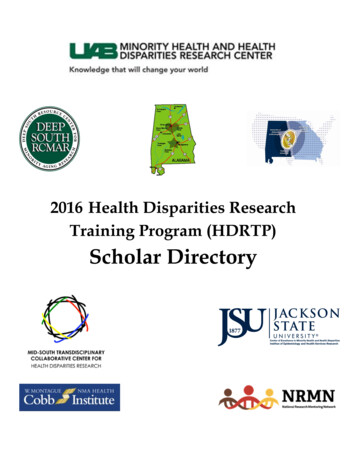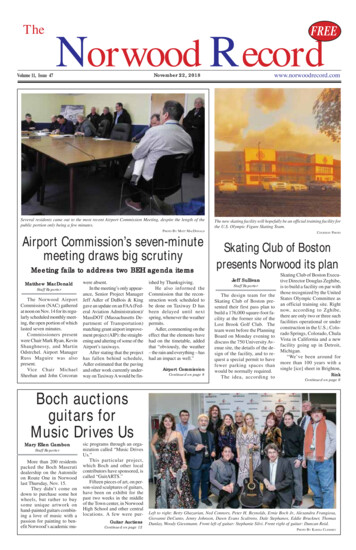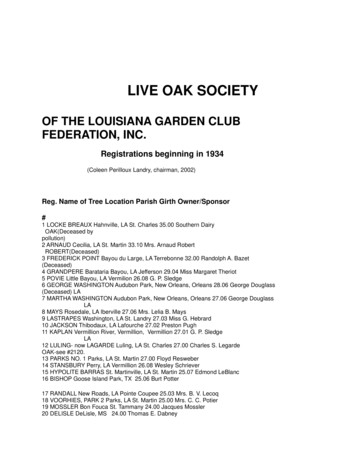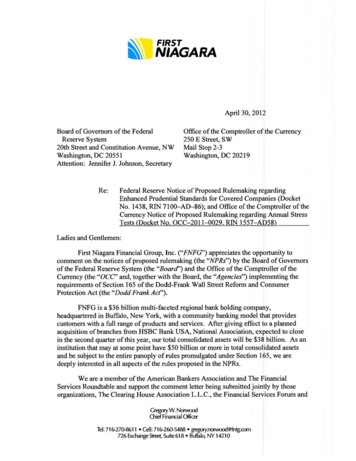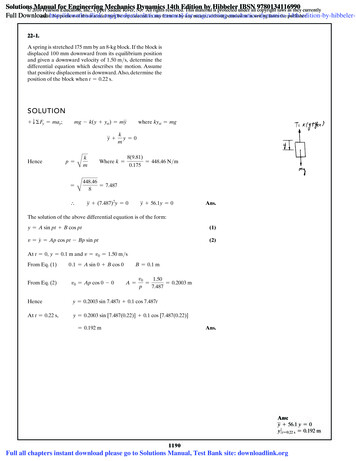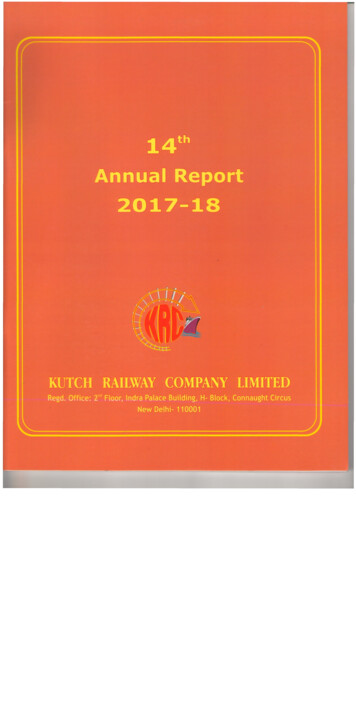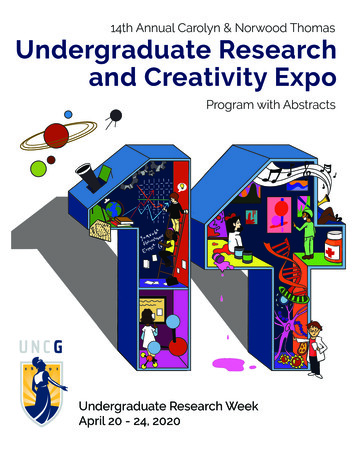
Transcription
14th Annual Carolyn & Norwood ThomasUndergraduate Researchand Creativity ExpoProgram with AbstractsUndergraduate Research WeekApril 20 - 24, 2020
14th AnnualCarolyn and NorwoodThomas UndergraduateResearchand Creativity Expo2020a unit within theUniversity Teaching & Learning Commons
utlc.uncg.edu/urscoPreston Lee Phillips Jr, Ph.D.DirectorAdrienne W. MiddlebrooksBusiness OfficerTraci Miller, MSAMARC Program: Academic Enhancement CoordinatorMaizie PlumleyGraduate AssistantAli Ramirez GaribayUndergraduate AssistantURSCO is a unit within theUniversity Teaching and Learning Commons
University Teaching and Learning Commons130 Shaw HallGreensboro, NC 27402-6170336.334.4776April 20, 2020Dear Students, Colleagues, and Guests,I would like to welcome you to the 14th Annual Carolyn and Norwood Thomas Undergraduate Research andCreativity Expo and the 1st ever Virtual Undergraduate Research and Creativity Expo at UNCG. Prior to therealization of the impact COVID-19 would have on the spring semester at UNCG, we were thrilled to accept266 presentations by more than 335 students, working with 146 mentors, and representing 38 academicdepartments/programs. As we moved the expo to a virtual platform, we are excited that 183 presentations weresubmitted.The Undergraduate Research, Scholarship and Creativity Office (URSCO) is dedicated to promoting andsupporting student success through mentored undergraduate research, creative inquiry and other scholarlyexperiences for the UNCG community. The URSCO is also dedicated to helping faculty become increasinglyeffective with mentoring undergraduate research and integrating research skills into courses and curricula. Theseexperiences can occur in many ways, including co- or extracurricular projects involving one or more studentsmentored by UNCG faculty. Scholarship is achieved by using the tools of an academic discipline to answerquestions that enhance knowledge and understanding. We seek to highlight the diversity of disciplinaryscholarship for and through our students in order to help cultivate a culture of life-long learning.The URSCO offers financial assistance to promote faculty-mentored student scholarship and creativity. Beforetravel suspensions went into place, we awarded travel assistance for more than 60 undergraduate opportunitiesto present the results of their inquiry at local, regional and national meetings. We have also provided supportfor 67 Undergraduate Research and Creativity Awards (URCA), of which 13 were part of the Globally EngagedURCA program and 4 were part of the Community Based URCA program. Finally, 7 students participated inthe Artists in Residence program, in partnership with the Lloyd International Honors College and the Collegeof Visual and Performing Arts.Today is a day to celebrate your scholarly accomplishments. I would like to thank all students and their facultymentors for taking the time to share your work with the university community. Many thanks go to the AssociateVice Provost of the University Teaching and Learning Commons, Dr. David Teachout, Vice Chancellor forResearch and Economic Development, Dr. Terri Shelton, as well as Provost Dana Dunn, and Chancellor FranklinGilliam for their support of the office and their unwavering dedication to student success. As always, specialthanks go to Mrs. Carolyn Thomas for her generous contributions in support of the Expo and faculty-mentoredundergraduate research. I would also like to thank Adrienne Middlebrooks, Traci Miller, Maizie Plumley, AliRamirez Garibay, Marisa Gonzalez and Damon Roberts for their efforts to ensure the success of today’s program.Sincerely,Lee Phillips, Ph.D.Director, URSCO
14TH ANNUAL THOMAS UNDERGRADUATERESEARCH & CREATIVITY EXPOTABLE OF CONTENTSAbout Carolyn and Norwood Thomas2020 Thomas Undergraduate Research Mentor Awards:12-5AbstractsAlphabetically by Student Last Name6-113NC Docks114Book Information115
CAROLYN AND NORWOOD THOMASCarolyn Styron Thomas graduated from Woman’s College, now UNCG, in 1954with a bachelor's degree in business. She is very committed to the success ofher alma mater and believes strongly in the value of education. “Theexperience of obtaining my college degree at Woman’s College gave meconfidence throughout my life to face challenges, raise my family and serve mychurch and community, all leading to a very rewarding life,” says Mrs.Thomas. To express their appreciation for Carolyn’s education, the Thomasesestablished an endowed fund in 1996 to support undergraduate and facultyresearch.Mrs. Thomas has served on the board of directors for the UNCG AlumniAssociation and, most recently, the UNCG Board of Visitors. She is a memberof the Harriet Elliott Society at UNCG. She has also been involved innumerous organizations in her hometown of Durham, NC, including theJunior League, the United Arts Council and the Methodist Retirement Home.Her husband, the late Norwood A. Thomas, Jr., graduated from DukeUniversity in 1955. The Thomases dated in college and were married for 46years. Mr. Thomas retired from his position as Executive Vice President atCentral Carolina Bank after 37 years. He later was a founding partner of theinvestment firm of Wilbanks, Smith & Thomas Asset Management of Norfolk,Virginia, where he worked for more than 10 years. Mr. Thomas was very activein community affairs in the Thomas’ hometown of Durham.14th Annual Carolyn & Norwood Thomas Undergraduate Research and Creativity Expo Page 1
2020 Thomas Undergraduate ResearchMentor AwardDr. Tyreasa Washington is the recipient of the 2020 Thomas UndergraduateResearch Mentor Award for tenured faculty. Dr. Washington joined theDepartment of Social Work at the University of North Carolina at Greensboro as anAssistant Professor in 2011. She was promoted to Associate Professor and appointedFaculty Affiliate to the UNCG Gerontology Program in 2017.Dr. Washington is a Licensed ClinicalSocial Worker (LCSW) who has workedin child welfare and mental healthsettings. She is a distinguished scholarwho examines the impact of familylevel factors on African Americanchildren’s social, academic, andbehavioral outcomes, especially thosewho reside in kinship care (e.g.,grandparents raising grandchildren).An extension of Dr. Washington’s workon African American kinship carefamilies in the United States is theexploration of the historic andcontemporary use of kinship careamong African American and Blackfamilies in the USA, Ghana, and SouthAfrica. She has presented her researchand led discussions at the Aya Centre for Intercultural Awareness and Development andthe University of Ghana in Accra, Ghana and at the University of Kwazulu-Natal inDurban, South Africa. Her research agenda also includes the examination of fathers’roles on children’s positive outcomes.Dr. Washington has received various research and teaching awards for her scholarshipincluding a Council on Social Work Education Minority Fellowship Alumna, a NationalInstitute of Health (NIH) Loan Repayment Program recipient, as well as, a TeachingExcellence and Research Mentor Awards recipient. Currently, Dr. Washington is thePrincipal Investigator of an Eunice Kennedy Shriver National Institute of Child Healthand Human Development (NICHD) funded study, entitled: “Development of AfricanAmerican Children in Kinship Care.”Former undergraduate student researcher, Christian Zik Nsonwu, said of hisrelationship with Dr. Washington, “During all of my successes and failures, she has14th Annual Carolyn & Norwood Thomas Undergraduate Research and Creativity Expo Page 2*
2020 Thomas Undergraduate ResearchMentor Awardalways been there to support me. I can say for an absolute fact that I would not bewhere I am today without her support and mentorship.”Dr. Washington served as a McNair Faculty Research Mentor to Kenya Downing andTamika Smith. Kenya stated, “It was not until I met this influential individual that Irealized how much exposure, representation, teaching, research, andmentoring matter.” Tamika recalled that, “Dr. Washington has supported me in allaspects, both domestically and internationally. She exemplifies the traits of acompassionate and determined mentor who believes in her mentees and will go aboveand beyond to support them. Dr. Washington is one of the few professors that Iencountered who made a conscious effort to individually connect with students beyondacademics.”Shelton Young explained, “Dr. Washington is not only a colleague in the Social Workprofession, but she once served as my professor and undergraduate research mentorduring my undergraduate experience. She provided me and countless others with anunderstanding of the importance of using research to inform social work practice andpractice to inform research.”The Undergraduate Research, Scholarship and Creativity Office at the University ofNorth Carolina at Greensboro established this award to recognize faculty who engagestudents in projects that contribute to the expansion of knowledge and understandingin their discipline, while demonstrating excellence and innovation. Dr. TyreasaWashington demonstrates role modeling as a professional, with personal integrity, highethical standards, and achievable standards for personal excellence. We are privilegedto recognize her with the 2020 Thomas Undergraduate Research Mentor Award.14th Annual Carolyn & Norwood Thomas Undergraduate Research and Creativity Expo Page 3*
2020 Thomas Undergraduate ResearchMentor AwardDr. Blair Wisco is the recipient of the 2020 Thomas Undergraduate ResearchMentor Award for Early Career Faculty. Dr. Wisco joined the faculty at UNCGin 2013 as an Assistant Professor of Psychology in the Clinical Psychology Program.Since then, she has mentored many undergraduates—nearly 25 in her PSY 433:Research Experience in Psychology coursealone. The results of her mentorship speakfor themselves. Three of her students havebeen awarded UNCG UndergraduateResearch and Creativity Awards funding,four have worked with her on honors thesesor independent research projects, and 10have presented posters at major regional andnational conferences. In one distinguishedcase, Dr. Wisco and a student collaborativelywrote and published an article in Cognitionand Emotion (Normansell & Wisco, 2017),an important peer-reviewed journal in thebehavioral sciences. Furthermore, herstudents have done well after leaving UNCG.Seven are in competitive, nationallyprominent graduate programs.In her teaching and research statement, Dr.Wisco remarked, “I am passionate aboutundergraduate research mentoring” and thatshe has consistently involved undergraduates in her research since joining UNCG. Herstudents are exposed to all stages of the research process, from the original conceptionof an idea to eventual dissemination of findings. Dr. Wisco’s receipt of an R15 grantfrom the National Institutes of Health, an award that aims to increase opportunities forstudent participation in research, reflects the high quality of her work and the uniquetraining opportunity that her lab provides. One student wrote of Dr. Wisco, “Sheconsiders the individual interests of research assistants in her lab and supports them.Time is taken to ask students what experiences they hope to gain from working in thelab, what they wish to learn. Dr. Wisco makes those opportunities available.”Another student wrote, “Dr. Wisco encourages her lab members to read and thinkcritically about current literature, learn new skills, and develop their own researchideas” and that she has been “one of my biggest supporters as a budding scholar.”Students agree that their time with Dr. Wisco benefited them greatly and helped thembecome more confident and skillful researchers. One student noted that Dr. Wisco is a“life-long mentor and amazing ally.”14th Annual Carolyn & Norwood Thomas Undergraduate Research and Creativity Expo Page 4*
2020 Thomas Undergraduate ResearchMentor AwardThe Undergraduate Research, Scholarship and Creativity Office at UNCG establishedthis award to recognize faculty members who engage students in projects thatcontribute to the expansion of knowledge and understanding in their discipline, whiledemonstrating excellence and innovation in doing so. Dr. Blair Wisco has managed todo this in exemplary fashion, and we are honored to present her with the 2020 ThomasUndergraduate Research Mentor Award.14th Annual Carolyn & Norwood Thomas Undergraduate Research and Creativity Expo Page 5*
ABSTRACTSThe Benefits and Challenges to Team Teaching in an Early ChildhoodInterdisciplinary ProgramStudent Author(s): Aliyah Janeen Aal-Anubia, Senior (Human Development andFamily Studies)Faculty Mentor(s): Heather Coleman (Specialized Education Services)At UNCG there is a Birth to Kindergarten (BK) undergraduate program. The program isinterdisciplinary with the departments of Human Development and Family Studies(HDFS) and Specialized Education Services (SES). Thus, many classes in the programare team-taught between an instructor from HDFS and SES, or instructors and graduateassistants, and some classes are team-taught with a family member that has a child witha disability. As part of on-going program development, the BK faculty gained students’and instructors’ perspectives on how effective the team-teaching process is, the benefits,and the challenges. The research team conducted surveys of students, and interviewedinstructors (faculty, adjunct, graduate assistants, and parent instructors) to gain theirperspectives. The team will share and publish the information they gather as an exampleof an effective interdisciplinary program that practices team-teaching.Switching Hypoxia Tolerance Strategies in the Brainstem of Bullfrogs,Lithobates CatesbeianusStudent Author(s): Sasha Adams, Junior (Biology)Faculty Mentor(s): Joseph Santin (Biology)Unlike humans, many vertebrate animals have the remarkable ability to surviveprolonged bouts of oxygen deprivation. The neural circuit that produces breathing in theadult American bullfrog, Lithobates catesbeianus, is a network that arrests activityduring anoxia. We’ve found that this network becomes 16 times more tolerant tohypoxia after frogs emerge from a cold-acclimation. This transition may reflect areduction in noradrenergic signaling and/or a shift in energy use/metabolism. We firstsought to identify if noradrenergic signaling is the sole cause of the arrest in controlnetworks. We expected that norepinephrine would occlude the arrest during hypoxia,however, it did not, implying the arrest does not involve noradrenergic signaling. To testour hypothesis that metabolic deficits may contribute, we applied inhibitors of glycolysisor mitochondrial respiration. Each inhibitor recapitulated the actions of hypoxia,demonstrating that deficits in ATP synthesis produce an arrest. Cellular energy sensors,14th Annual Carolyn & Norwood Thomas Undergraduate Research and Creativity Expo Page 6
ABSTRACTSsuch as KATP channels and AMP-dependent protein kinase, are known to reduceneuronal activity when ATP falls; however, activation of these mechanismspharmacologically failed to arrest activity. A better understanding of how this networkshifts from an arrest strategy to functional tolerance has the potential to uncover newprinciples for neuronal energetics relative to human diseases.Female Film Directors Are More Likely to Create Stories with StrongFemale Characters - Positively Influencing How Young Woman See TheWorldStudent Author(s): Emma Albrecht, Sophomore (Media Studies)Faculty Mentor(s): Sara Littlejohn (Ashby & Strong College)Movies are a large part of today’s culture and they influence how people view the world.Currently, female directors are vastly underrepresented in the film industry and areoften overlooked in favor of their male counterparts. This means that the films that arecurrently being created are showing the world from only one point of view. This isimportant because it can drastically affect how people, especially young women, viewthe world. This is why I argue that the world needs more female film directors becausethe work that they create portrays strong female narratives that can positively influencehow young women view themselves and the world. Using sources such as the bookCelluloid Ceiling: Women Film Directors Breaking Through I will prove that there is aneed for more female directors. The stories they tell are more likely to have a strongfemale character as the protagonist than male directed movies. It is important to me andI will prove why it should be important to you that young women see female characterson screen being portrayed as strong, independent, and capable of holding positions ofpower because that shows them that they are capable of doing that too.Factors Driving Hispanics in the USA to Avoid Professional Medical CareStudent Author(s): Diana Angeles, Sophomore (Pre-Health Studies)Faculty Mentor(s): John Sopper (Grogan College)Early detection of diseases and illnesses is critical to the survival of patients andaffordability of health care. Hispanics, the largest ethnic minority in the United States,tend to access medical/preventive care at lower rates than other groups and in a less14th Annual Carolyn & Norwood Thomas Undergraduate Research and Creativity Expo Page 7
ABSTRACTStimely manner. (O’Hara & Caswell, 2012, pg. 9). This pattern results in Hispanics beingat higher risk for undiagnosed chronic diseases, limiting their awareness of treatmentplans available. The focus of this project is to identify the factors that contribute to thelower incidence of accessing medical care by Hispanics in the USA. More specificallyexamining the extent to which a cultural stigma around medical care is a contributingfactor. The research strategies of this project include a literature review of journalarticles, analysis of census findings & other government and agency databases. There isan expectation to find a range of factors impeding Hispanics from not only seekingprofessional health care when needed, but also utilizing preventive care. Understandingthe factors that contribute to the disparities of healthcare for Hispanics will create abasis for constructing a new way of treating and informing Hispanic patients, therebyimproving overall health outcomes.Balance Confidence During a 12-Week Attentional Focus Balance TrainingIntervention for Older Adults with Fall RiskStudent Author(s): Zoe Austin, Junior (Kinesiology)Faculty Mentor(s): Louisa Raisbeck (Kinesiology)In older adults, the relationship between balance confidence (BC) and poor posturalcontrol is well established. Current fall prevention interventions are moderately effectiveat improving BC and postural control; however, they focus primarily on biomechanicalaspects related to postural control and neglect cognitive factors, such as attentionalfocus (AF). Thus, the purpose of this study was to examine if AF instructions duringbalance training predict change in BC for older adults with fall risk. Older adults(N 52), who reported falling during the previous 12-months, were assigned to an EF orinternal focus (IF) group. Participants completed a 12-week wobble board balancetraining intervention twice per week for 20 minutes with AF instructions. At baseline(Week 0), midpoint (Week 6), and post-intervention (Week 12), participants completedthe Activities-specific Balance Confidence Scale (ABC-6). A linear growth model wasestimated using hierarchical linear modeling to assess the effect of condition onindividual growth trajectories of BC during the 12-week intervention. Condition did notsignificantly predict baseline BC or the BC growth curve p .05. These results suggestthat a balance training intervention using AF instructions may not influence BC in olderadults.14th Annual Carolyn & Norwood Thomas Undergraduate Research and Creativity Expo Page 8
ABSTRACTSSolitary Confinement is a Failed PracticeStudent Author(s): Ocean Bailey Ramirez, Junior (Sociology)Faculty Mentor(s): Sara Littlejohn (Ashby College & Strong College)Solitary confinement is a popular form of punishment within prisons. When inmatesdeviate from the rules of the prison, prisons tend to look towards isolation as theultimate method to correct inmate divergence. If an inmate attempted suicide,depending on the amount of offenses, they’re sent to isolation for a lengthy periodrather than initiating proper healthcare. I argue that we shouldn’t use solitaryconfinement as a form of deterrence within prisons because it has negative effects oninmates that cause the emergence of multiple psychological disorders, that result inadded stress to mental conditions that an inmate possibly has, which can result inphysical harm on themselves or towards others. This topic is important to me because itexposes the true treatment of criminals within prisons and what people suppress abouttheir treatment. Sources that would be useful regarding this particular topic would beprisoner blogs, documentaries about the personal accounts of inmates, and articleinterviews from the perspective of psychologists such as “The Hidden Damage ofSolitary Confinement” by Ramin Skibba. Isolation as a punishment is a practice thatshould not continue within prisons but rather replaced by alternative methods thatimprove inmates mental and physical healthAre Your Needs Met? An Analysis of Basic Necessities of Guildford CountyOlder Adults in Nepali/Bhutanese and Congolese Refugee CommunitiesStudent Author(s): Alisha Baity, Senior (Social Work), Ireti Adegbesan, Post-Bac(Human Development and Family Studies)Faculty Mentor(s): Sudha Shreeniwas (Human Development and Family Studies)Many refugees in the US are living in poverty and fall into the gaps in services providedby the welfare state safety net, such as Food Stamps, SSI benefits, and affordablehousing, despite being eligible for these benefits. These needs and gaps may be greaterfor older adult refugees due to their age and other factors. We conducted a needsassessment of older adults in the Congolese and Nepali/Bhutanese refugee communitiesin the Guilford County area. The study was conducted using semi-structured interviews,to aid in understanding the needs of older adult refugees. This presentation willhighlight the stories of refugee older adults in the area and how their basic needs for14th Annual Carolyn & Norwood Thomas Undergraduate Research and Creativity Expo Page 9
ABSTRACTShousing, food, and clothing aren’t being met. We will identify gaps in services andinclude key community recommendations pertaining to the two refugee communities.Artificial Emotional Intelligence: Perfectly Imperfect Performance in PierceGradone’s “Automaton”Student Author(s): Taylor Barlow, Junior (Music)Faculty Mentor(s): Andrew Hudson (Music)Computers have evolved to become a prominent part of everyday life, making it easier tocomplete most tasks with fewer errors. Pierce Gradone’s “Automaton” for solo bassclarinet recognizes the role technology began to play in music during the 1940’s and1950’s and continues to play today. Performers can sometimes be viewed as an“imperfect shadow” when compared to a computer’s capability to execute “flawless”performance. Many musicians chase after perfection in fear of becoming obsolete.However, what does it truly mean to be “flawless?” A computer is incapable of playingfrom the heart in the way humans are, often making our supposedly “flawed”performances more personal. “Automaton” deploys many “heartless” machine-likequalities through the use of extended techniques. This presentation focuses on enablingperformers to walk the line of machine-like perfection and organic expression byexploring Gradone’s usage of extended techniques, and how to engage them from eithermusical perspective. The piece starts with a machine-like passage of notes characterizedby key clicks. As “Automaton” progresses, these machines crumble and a human voiceemerges, leaving the technology either obsolete or wholly organic, and us to wonderwhether we are hearing a truly human voice or a flawless computer reproduction.The Montagnard Population Count Project (MPCP): Descriptive FindingsStudent Author(s): Emanuel Barrera, Senior (Public Health Education)Faculty Mentor(s): Sharon Morrison (Public Health Education), Sudha Shreeniwas(Human Development and Family Studies)Montagnards (“Mountain-dweller”) are indigenous people from Vietnam’s highlandswho fought alongside U.S. military troops and faced retribution from the Vietnamgovernment. They began resettling in 1986 to North Carolina (NC), with the majoritynow living in Greensboro, NC. We have no exact population numbers and this lack ofenumeration means Montagnards remain an underserved and underrepresented AsianAmerican group. The Montagnard Population Count Project (MPCP) is a community14th Annual Carolyn & Norwood Thomas Undergraduate Research and Creativity Expo Page 10
ABSTRACTSacademic collaboration effort to count Montagnards, and describe their health status,strengths, and challenges. Our guiding questions are 1) How many Montagnards live inthe Greensboro area? 2) What is the age and sex profile? 3) What are the main healthconcerns? and 4) What does the community perceive as their greatest strengths andchallenges? Our team used a culturally modified U.S. Census-based survey to collectdata in Greensboro neighborhoods with Montagnards. Findings from 61 householdsindicate 144 males (52.6%) and 130 (47.4%) females, with ages ranging from 1 to 77.Health concerns included elder care needs, lack of insurance, unsafe housing andlanguage barriers in healthcare. Findings underscore the importance of Montagnardinclusion in local, regional and national databases on Asian Americans.Gendered Translation: Exploration of the Target Texts of Sign LanguageInterpretersStudent Author(s): Brianna Bear, Junior (PiD Interpreter Preparation), AndreaShealy, Sophomore (Specialized Education Services), Abigail Copen, Junior (SpecializedEducation Services)Faculty Mentor(s): Campbell McDermid (Professions in Deafness)American Sign Language (ASL) is a visual-spatial language that differs from spokenlanguage, such as English. One way is in the use and characteristics of pronouns (Meier,1990). Pronouns in ASL, for example, are created by pointing to objects or locations inspace (written in English here as POINT), and do not have a gender assigned to them asthey do in English (he, she, him, her). So, interpreters must decide which gender to use.Limited research has been done on this topic (Quinto-Pozos, Alley, Casanova de Canales& Treviño, 2015), and so a study was created to address this gap. As part of the method,a small cohort of interpreters were asked to translate four stories from ASL into Englishconcerning four different occupations (engineer, teacher, truck driver, secretary). Thesetranslations were videotaped. The researchers compared the number of references in theASL stories (POINT) to the number included by the interpreters and looked at thegender the interpreters assigned the references. Preliminary data indicate that mostinterpreters assign a male gendered pronoun (he) for occupations statistically occupiedby men and a female gendered pronoun (she) for occupations statistically occupied bywomen (Bureau of Labor Statistics, 2018).14th Annual Carolyn & Norwood Thomas Undergraduate Research and Creativity Expo Page 11
ABSTRACTSSymposia in the Periphery: Koressos on Kea and Sympotic IdeologiesStudent Author(s): Michael Bell, Senior (Classical Studies)Faculty Mentor(s): Joanne Murphy (Classical Studies)The symposion (pl. symposia) was a uniquely Greek form of drinking party in which itsparticipants, usually of the same economic status, drank water-mixed wine and engagedin an assortment of leisure activities. The institution is often attested in Greek literatureof the Archaic to Hellenistic periods (8th to 1st century BCE).In this paper I will argue that symposia were not merely settings for alcoholconsumption among social peers. In fact, they also presented a venue for theproliferation and concentration of power among upper-class Greeks through mutualobligation and the development of political and economic networks. I will also trace thedevelopment of the city-state of Koressos on the island of Kea by investigating theproliferation of symposion ideologies and practices through material evidence collectedby the Kea Archaeological Research Survey.I will apply GIS data of surface-collected fragments of ceramic vessels used exclusivelyfor symposia in order to characterize the spread of sympotic activities to Kea from theGreek mainland. I will also draw upon anthropological correlates related to hospitalitypractices to explain how the development of Koressos might have been facilitated by theparticipation of its elites in symposia.How the Modern Patriarchy is Sustained by the Misuse of Religious TextsStudent Author(s): Rylee Bennett, Senior (Media Studies, Spanish)Faculty Mentor(s): Sara Littlejohn (English)Throughout history, religion has been used as a basis for teaching morals, ethics, andhierarchy within many societies. However, I argue that a lot of the texts quoted arebeing misused or taken without full application. Taking a more specific look at theJehovah’s Witness religious organization, one can see many examples of biblical textsbeing misused or applied without taking into account the full context. I am personallyinterested in this topic as a LGBTQ , feminist, cis-gender woman and as a formerJehovah’s Witnesses who grew up within the patriarchal system of the organization.Using sources directly from the Watchtower and Tract Society of Pennsylvania (theofficial publisher name for Jehovah’s Witnesses) and Sheila Jefferys’ Man's Dominion :Religion and the Eclipse of Women's Rights in World Politics the analysis of religious14th Annual Carolyn & Norwood Thomas Undergraduate Research and Creativity Expo Page 12
ABSTRACTStexts and applied reasoning cl
Greensboro, NC 27402. April 20, 2020 . Dear Students, Colleagues, and Guests, I would like to welcome you to the 4th Annual Carolyn and Norwood Thomas Undergraduate Research and 1 Creativity Expo and the 1st ever Virtual Undergraduate Research and Creativity Expo at UNCG. Prior to the realization of the impact COVID-19 would have on the spring semester at UNCG, wwere thrilled e to accept
